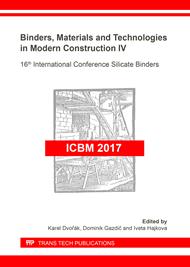p.204
p.210
p.217
p.223
p.229
p.236
p.242
p.248
p.254
Comparison of Automated Concrete Shrinkage Measurement Methods
Abstract:
Volumetric changes are deformation properties of concrete that are caused by external or internal forces and can be reversible or irreversible. Relatively significant and irreversible volumetric changes occur during the hydration of clinker minerals during the first stages concrete setting and hardening. From the “real-world” point of view, the volumetric changes associated with drying are the most important – these take place when the leftover mixing water evaporates. The current legislation addresses the volumetric changes of concrete relatively briefly and the calculations of the assumed autogenous shrinkage according to Eurocode 2 are generally related only to the concrete’s strength class, not to the composition of the concrete mixture. The principle of determination of volumetric changes is classified by the standard ČSN 73 1320, which requires the measuring devices with an accuracy of at least 1∙10-5 of expected proportional deformation. In this experiment, the volumetric changes of the concrete will be monitored by two different measurement methods. Several different test mixtures will be prepared to monitor these changes continuously with an automatic measuring device. In one case, the measurement will take place from the point of fresh concrete and, in the case of the others, immediately after the acquisition of the handling strength, i.e. from the age of 1 day.
Info:
Periodical:
Pages:
229-235
Citation:
Online since:
June 2018
Authors:
Keywords:
Price:
Сopyright:
© 2018 Trans Tech Publications Ltd. All Rights Reserved
Share:
Citation:


